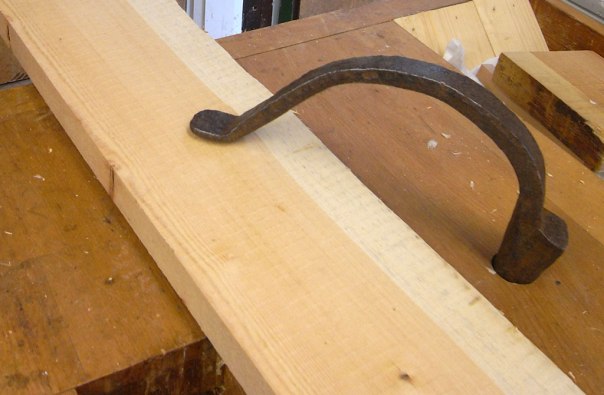
Tomas has posted about holdfast in Sweden where he present old original holdfasts from the southern part of Sweden, Skåne or Blekinge. There are two different patterns of holdfast and the one that seems to be the oldest are on the picture above. The blacksmith Mattias Helje in Lima in Sweden have tried to analyze how it could have been made. There are at least three different ways to forge a holdfast. One is to forge it from a single piece of iron with a dimension thick enough to forge the stem and then stretch out the arm. This is the method used by Øystein Myhre that forged the Norwegian patterns of holdfast. The same method is also demonstrated in a video of Peter Ross and Roy Underhill. One other method is to use a similar dimension of iron and forge it from two pieces, one for the stem and one for the arm and forge weld the two pieces together like the one below from Nordmøre in Norway.

There is also a third way to forge a holdfast. You could start with a dimension that is more like the thickness of the arm and then make the stem by forge welding a piece on to it.





This are different patterns and different ways to make holdfasts in Sweden and Norway. Tomas and I has also done some research of what the holdfast are, or was, called in our languages. I have seen the post about this matter on the Lost Art Press blog, How do you say «holdfast»? The Norwegian names I have posted there are these:
Kjellingfot – if translated to English – goat kid foot
Benkehake – bench hook
Hallhake – hold hook
Hake – hook
Hallfast – holdfast
Ronghake – crocked hook.
Bukkefot – rams foot, this word is from Øystein Myhre that uses the holdfast in his work as a Norwegian blacksmith.
In Swedish there are the names «bänkhållare» (bench holder) and «knekt» (could translate to bracket or something?) in the book “Träslöjd”, Hallén & Nordendal (1923).
In inventories in workshops in Stockholm in the early 1700`s there is several mentions of “stämhake”. That could be the same as holdfast. It could translate to “stem hook».
Tomas has also learnt the word “fans tumme”, that means “devils thumb”. That is a parallell to the Norwegian joiners “killingfot” (goat kid foot) and blacksmiths “bukkefot” (rams foot). Both refer to a goat foot and the goat and the devil are considered as related in folklore. The devil is usually equipped with rams horn.

Excellent information. Thank you for the post in English. Many readers in the US and Canada will be interested in what you are doing. Unfortunately, there are so many woodworking sites in the US that the search engines rarely come up with anything pertinent in languages other than English. The work that you are doing is intriguing. More US readers should see it. BTW, does the traditional style holdfast with the «built up» shank tend to damage the holes in the bench top?
Thank you for your comment. Those new holdfasts that Mattias Helje has made are not yet tested. Tomas has used his original, the one on the picture in the top of this post. I do not think that there has been serious damage on the hole in his bench. Tomas has currently been using an old bench with the bench top made of beech.
On my own bench made from pine I have seen a bit more damage to the holes in the bench top when I use holdfasts that are more like the French with thick dimension and little flex in the arm. The latest holdfasts that Øystein Myhre has made seems to work better in my bench made of pine and with a 3″ thick bench top. https://hyvelbenk.files.wordpress.com/2014/02/bilde9.jpg
I will continue to test the different patterns of holdfasts both in my bench made of pine and in our coming copy of the bench from Vasa. This last one is made of oak and have a bench top of about 3″